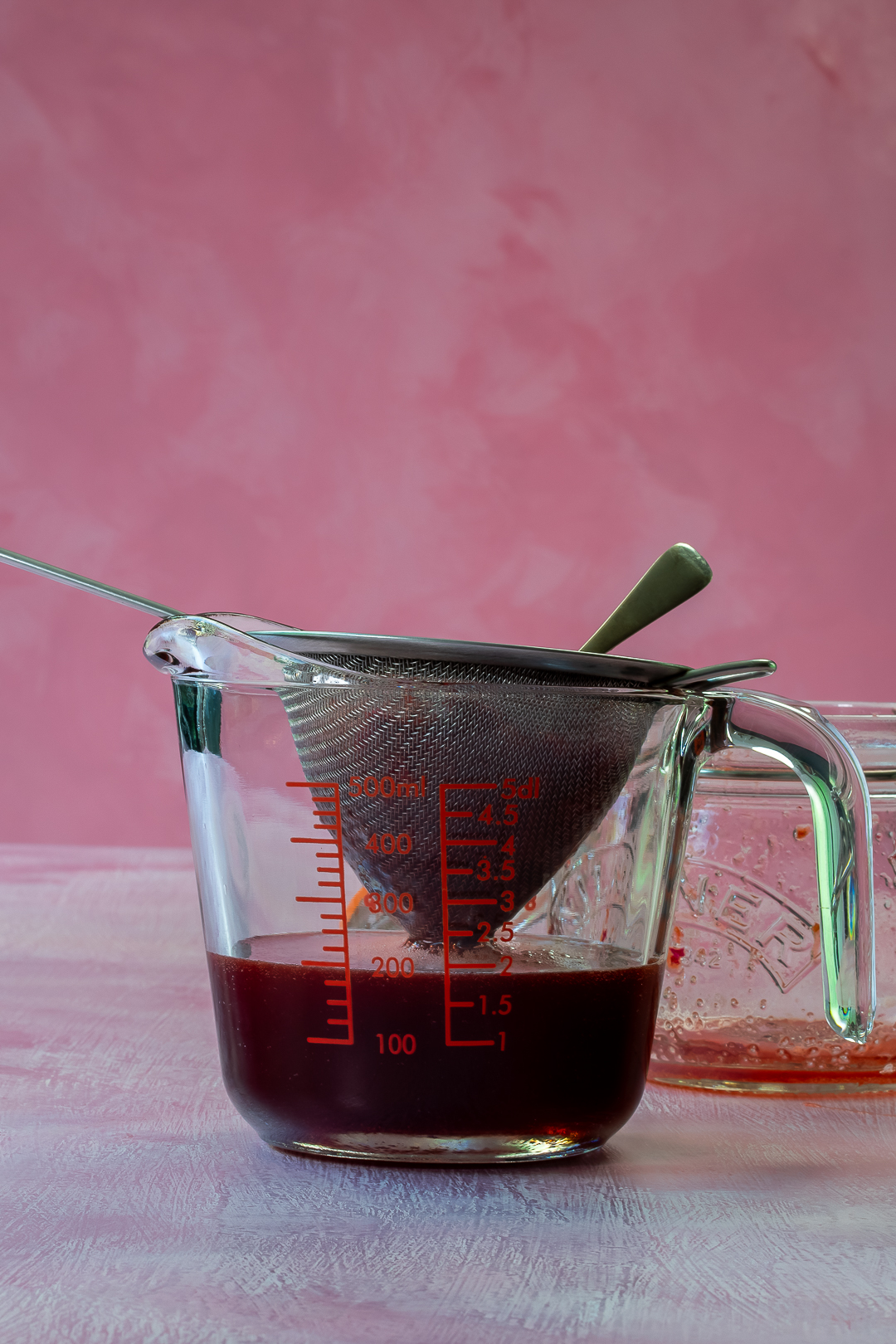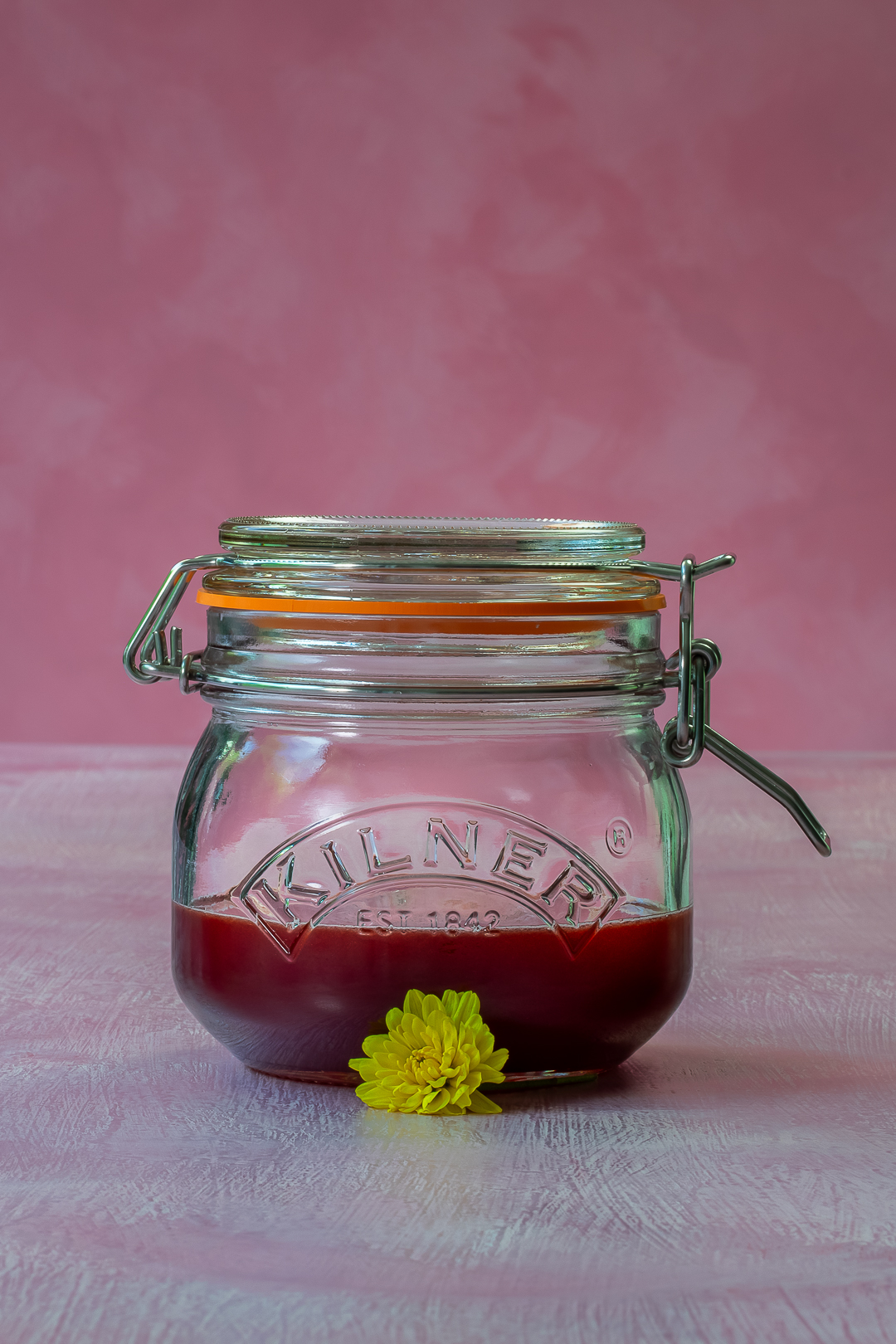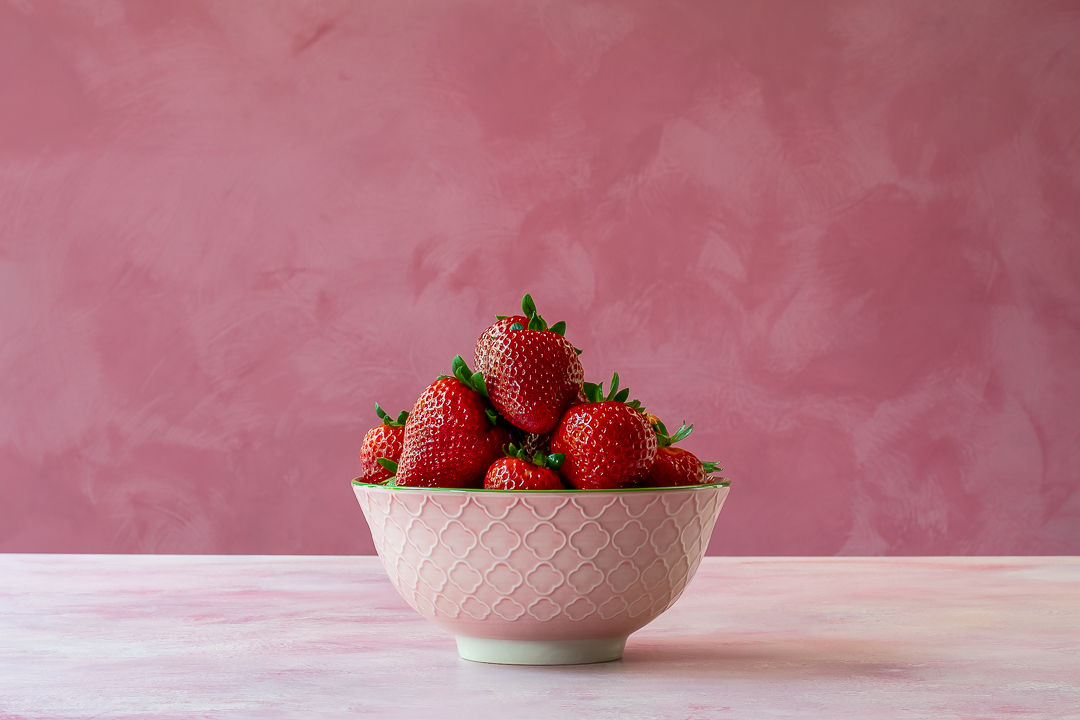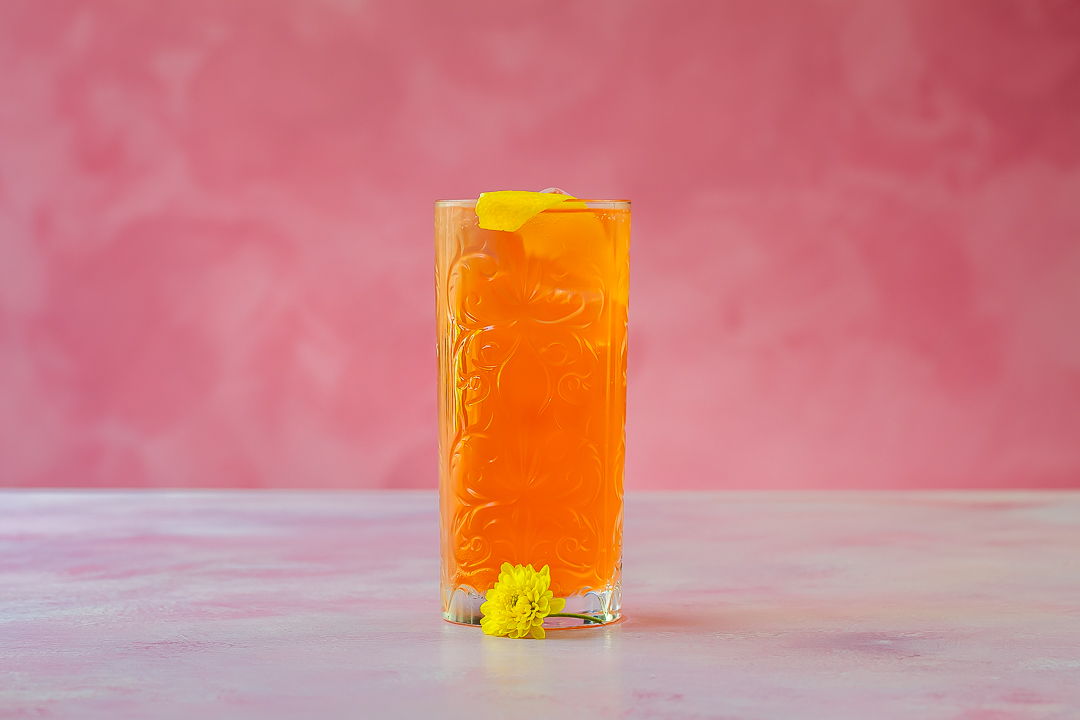Strawberry Tequila Collins is a seasonal strawberry twist on vintage Collins recipes, such as Edward F. Barry’s 1873 John Collins and Jerry Thomas’ 1876 Tom Collins Gin – calling for sugar, lemon, Old Tom Gin, Soda Water and ice, and in the John Collins a lemon twist. Here I use a Strawberry Syrup with rose petals and hibiscus for sweetening instead of plain sugar or syrup, adding tart fruity, floral and spicy notes balanced with fresh lemon for souring that complements a base of Tequila rather than Old Tom Gin. Instead of lengthening with Soda Water the whole cocktail including cool filtered water is added to a carbonator and carbonated for extra fizz, served over rocks of clear ice in a tall Collins glass and garnished with a lemon twist. Strawberry Tequila Collins is a celebration of in season tart sweet strawberries paired with refreshing sour lemon amplified with floral notes from rose and spiciness from hibiscus.
What is a Collins? Long Sour Drink, Spiked Lemonade
The Collins is a family of long Sour drinks calling for sugar, lemon juice and a spirit, the signature being Old Tom Gin, and Soda Water, either built in a tall Collins glass with all ingredients added and stirred over ice, or shaken with ice and strained into an ice filled Collins glass and topped with Soda Water, sometimes finished with a lemon twist. David Embury (1948: 290) in The Fine Art of Mixing Drinks writes that the Collins can be understood as a long Sour drink or as a spirit ‘spiked’ Lemonade:
“Basically, the Collins is simply a Sour served in a tall glass with ice and charged water. Or, stated another way, it is a lemonade made with charged water and spiked with Gin or some other liquor.”
David Embury (1948: 290). The Fine Art of Mixing Drinks. Mud Puddle: New York.
Origins of the Collins: Limmer’s Punch, Old Tom Gin, John Collins, Limmer’s Hotel London 1834
David Wondrich (Wondrich 2022: 188-189) in The Oxford Companion to Spirits & Cocktails writes that the Collins has origins in Gin Punch recipes from the 1800’s that were at first lengthened with plain water and then with bubbly Soda Water. David Wondrich in Punch (Wondrich 2010: 205-212) details that Limmer’s Punch reported circa 1834 but likely older was made by Head Waiter and Bar Manager John Collins of Limmer’s Hotel, London, with sugar, lemon peel, lemon juice, Old Tom Gin, and an accent of English style Capillaire Syrup (2 parts sugar, 1 part water, and an accent of orange flower water), water and chilled Soda Water. Garrick Club Punch shares the same formula except Maraschino Liqueur is used instead of Capillaire (Wondrich 2010: 205-212).
Collins Variations: From John Collins to Tom Collins and the whole Collins Family
Collins recipes in the 1870’s using the signature Old Tom Gin could be called a John Collins, but later recipes with Old Tom Gin came to be known as a Tom Collins, with a Hollands Gin or Genever variation taking over the name John Collins, other 1870’s variations included Brandy and Whiskey (see Wondrich 2015: 95). Later Collins variations are numerous using different spirits, souring agents and sweeteners. David Embury (Embury 1948) and Trader Vic (Bergeron with Sarvis 1972) offer many Collins variations including Dry, Sloe and Mint infused Gin, Rum, with lime or with lime and mint, Whisky, sometimes with Grenadine, Applejack, Vodka, Tequila, sometimes with lemon and lime, and Pisco. In some modern variations sugar is swapped out for Elderflower Liqueur (Gray 2017) or in a non-alcoholic variation, Elderflower Syrup (deBary n.d.).
Collins variations are confusingly renamed, or newly named in reference to their base spirit or specialist ingredients – reinventing and extending the Collins family. For example, in the 1940’s John Collins uses American Whiskey and Tom Collins London Dry Gin, other variations include Pierre Collins (Brandy), Pedro Collins (Rum), Jose Collins, Pepito Collins, Juan Collins (Tequila) and many more (Wondrich 2022: 188-189; Difford n.d.: a & b; Bergeron with Sarvis 1972; Embury 1948). Others use the name Collins and refer to signature ingredients such as Elderflower in the Elderflower Tom Collins or non-alcoholic Elderflower Collins (Gray 2017; deBary n.d.). Some have their own unique name such as Jeffrey Morgenthaler’s (Morgenthaler 2007) Santa Carla using Tequila Blanco, lemon, sugar syrup, Grapefruit Bitters and Soda Water.
Collins Recipes: John Collins, Tom Collins Gin, Tequila Collins, Santa Carla
Below I offer a close reading of Collins recipes beginning with vintage 1870’s John Collins and Tom Collins recipes to later variations using Tequila as a base spirit. Vintage Collins recipes from the 1870’s used a long Sour formula of sugar, lemon, Old Tom Gin, Soda Water, ice and sometimes lemon peel, served in a tall Collins glass and could be known as a John Collins such Edward F. Barry’s John Collins recipe (Anon. 1873: 3) and later as a Tom Collins such as Jerry Thomas’ (Thomas 1876: 91) Tom Collins Gin recipe. Later Tequila variations of the Collins could follow the vintage Collins spec and simply swap out the Gin base for Tequila as in David Embury’s (Embury 1948: 292) Tequila Collins. More creative interpretations change not only the base but the souring agent, measures and presentation or add new ingredients, as in the tropical style Tequila Collins Highball of Trader Vic (Bergeron with Sarvis 1972: 205) with lemon and lime and a fancy spent lime shell and fruit stick garnish or the contemporary Santa Carla of Jeffrey Morgenthaler (Morgenthaler 2007) where Tequila Blanco is accented with Grapefruit Bitters in a Collins garnished with a lemon wheel and fresh mint.
John Collins, Old Tom Gin, Mr. Edward F. Barry, Everett House New York, The Sun, 1873
A John Collins recipe of Bartender Mr. Edward F. Barry of Everett House, New York is reported in The Sun (New York) August 22 1873 in an anonymous article entitled American Fancy Drinks (Anon. 1873: 3) calling for lemon, sugar and Old Tom Gin, Soda Water, ice and lemon peel. The inclusion of the lemon peel in Edward F. Barry’s John Collins recipe is of especial importance – as the lemon peel adds essential oils thus boosting the experience of refreshing sourness and lemon flavour. The lemon peel was also a key ingredient in earlier Gin Punch recipes. David Wondrich (2015: 94-97) in Imbibe! offers helpful interpretation of Edward F. Barry’s John Collins recipe pointing out that the bottle of Soda Water would likely have been a 6 oz. measure. The anonymous author (Anon. 1873: 3) of American Fancy Drinks in The Sun (New York) August 22 1873 reports on how Mr. Barry made his John Collins by the method of building in the glass adding sugar, lemon and Old Tom Gin (or Brandy) with chilled Soda Water, stirring with ice and finishing with a lemon twist:
“Mr. Barry makes his John Collins morning soother by mixing a tablespoonful of powdered sugar, the juice of half a lemon, a wine glass of Old Tom gin, a bottle of plain soda, stirred with ice, and a slice of lemon peel. Some educated drinkists substitute brandy for the gin.”
Anon. (1873: 3). American Fancy Drinks. The Sun (New York), August 22, 3.
Note that the Cocktail Kingdom reproduction of the American Fancy Drinks article is easier to read than the badly faded original copy of The Sun (New York) August 22 1873 held in the Library of Congress. Edward Barry’s Collins recipe is unique for its detail of the lemon twist garnish, but David Wondrich (Wondrich 2022: 188-189) in The Oxford Companion to Spirits & Cocktails writes that there are earlier reports of the Collins from 1865 onwards, with one also appearing in The Sun (New York) 4 July 1872 in an anonymous article (Anon. 1872: 2) entitled The Melting Metropolis – note that this earlier instance of the recipe does not include the lemon peel garnish.
Tom Collins Gin, Old Tom Gin, Jerry Thomas, The Bar-tender’s Guide 1876
A recipe for a Tom Collins Whiskey is published in Jerry Thomas’ (1876: 91) The Bar-tender’s Guide along with variations for a Tom Collins Brandy and Tom Collins Gin – the formula calls for Gum Syrup, lemon juice and spirit to be served shaken with ice and strained into a large bar glass to be topped with bubbly or ‘lively’ Soda Water. David Wondrich (2015: 96) clarifies that the unstipulated Gin in the recipe should be Old Tom Gin. Jerry Thomas (1876: 91) writes of the method of making the Tom Collins Whiskey – and notes that the Tom Collins Brandy and Tom Collins Gin are to be made ‘The same as Tom Collins Whiskey’:
“5 or 6 dashes of gum syrup.
Jerry Thomas (1876: 91). The Bar-tender’s Guide. Dick & Fitzgerald: New York.
Juice of a small lemon,
1 large wineglass of whiskey.
Fill the glass half full of shaved ice, shake up well and strain into a large bar glass.
Fill up the glass with plain soda water and imbibe while it is lively.”
Tequila Collins, David Embury The Fine Art of Mixing Drinks 1948
David Embury’s (1948: 292) Tequila Collins in The Fine Art of Mixing Drinks follows his Gin Tom Collins template of sugar syrup, lemon juice and spirit (Tequila) topped with Soda Water and served with ice, made by the method of building in a tall 12-16 oz. Collins glass and stirring with ice. Note the larger measure of spirit used 3-4oz. compared to the 2oz. of the 1870’s recipes, with 1tbspn of sugar syrup and the juice of a whole medium lemon – the larger scale to match the large Collins glass of up to 16oz.
Tequila Collins, Trader Vic’s Bartender’s Guide: Revised 1972
Trader Vic’s (Bergeron with Sarvis 1972: 205) Tequila Collins in Trader Vic’s Bartender’s Guide: Revised is a tropical style Tequila Highball using in comparison only 1 oz. Tequila to 1oz. lemon juice and 1/2 oz. sugar syrup along with the juice of half a lime, topped with Club Soda and served in a Highball glass with ice, to be built in the glass and stirred with ice and garnished with the spent lime shell and a fruit stick and served with straws.
Santa Carla, Tequila, Jeffrey Morgenthaler 2007
Jeffrey Morgenthaler’s (2007) Santa Carla uses 2 oz. Silver Tequila, 1 oz. lemon, ¾ oz. sugar syrup, creatively accented with 3 dashes Grapefruit Bitters, to be built in a 14oz. Collins glass and topped with Soda Water and garnished with an aromatic lemon wheel and a fresh mint sprig.
How to make a Collins? Build in the Glass, Shake & Strain, top with Soda Water
The Collins can be made by two main methods:
- Build in the Glass: Building in a tall Collins glass with ice by adding lemon sugar and spirit, topping with chilled Soda Water, stirring, and garnishing with a lemon twist
- Shake & Strain, top with Soda Water: Shaking lemon, sugar and spirit with ice and straining into an ice filled Collins glass and topping with chilled Soda Water

How is the Strawberry Tequila Collins Different?
The Strawberry Tequila Collins builds onto vintage Collins recipes and later Tequila variations exploring seasonal tart sweet strawberries and pairing these with refreshing sour lemon – the fruity and floral notes of lemon and strawberry are emphasised through use of floral rose and a contrast is added through spicy and savoury notes of hibiscus that work well with the Tequila base. Instead of the traditional method of building in the glass and stirring with ice or shaking with ice and straining into an ice filled Collins glass and topping with chilled Soda Water I carbonate the whole chilled drink for additional bubbles that bring the fruity-floral-spicy Strawberry Syrup matched with Tequila directly to the nose of the drinker. The carbonated Strawberry Tequila Collins is poured over ice into a Collins glass and finished with a lemon twist which brings in fruity floral lemon oils that amplify the fruity sourness of lemon and tart sweet strawberries.




Strawberry Syrup
Strawberry Syrup with rose petals and hibiscus replaces the plain powdered sugar or Gum Syrup of vintage Collins recipes and adds tart, fruity, floral and spicy notes that complement lemon and Tequila along with a bright red colour courtesy of the hibiscus. The method used to make Strawberry Syrup is informed by the cold process maceration of Emil A. Hiss’ (1897: 88) soda syrup recipe for Strawberry Syrup II in his The Standard Manual of Soda and Other Beverages although here I have used demerara sugar for rich molasses notes and added rose petals and hibiscus for floral and tart, spicy notes and a bright red colour. Use of a sealed vessel for maceration is informed by Jeffrey Morgenthaler’s (2012) Vacuum Seal Oleo Saccharum where he makes use of the water absorbing properties of sugar enhancing these by using a sealed vessel to draw out essential oils from lemon peel.


Here I adapt the use of a sealed vessel for maceration, but use washed, hulled and sliced fresh in season strawberries, rose petals and dried hibiscus flowers with demerara sugar – the resulting syrup is quick and easy to make as the sugar does most of the work for you, it only requires muddling and a 2 hour maceration in the fridge, a final muddling and a little stirring to incorporate the sugar. Once the sugar is incorporated I fine strain the Strawberry Syrup into a jug and then decant into a preserving jar. Store the finished syrup in the fridge – it will last up to 2 weeks in the fridge.

The advantage of using a cold process is that the bright qualities of the fruit are retained. Strawberry Syrup is a rich fruity and tart, sweet syrup with an amazing bright red colour and floral and spicy notes that connect with floral notes in lemon while the spicy hibiscus and fruity strawberry are a great match for Tequila.

Lemon
I use lemon as a souring agent in this Collins retaining the lemon from vintage recipes. Lemon has floral notes that connect with the floral rose petals and hibiscus used in the strawberry syrup.
Tequila
The Old Tom Gin of the vintage Collins recipes is swapped out for Tequila here which marries well as a base for the spicy, floral, fruity Strawberry Syrup balanced with lemon. I first tried this with a Tequila Blanco with fruity, floral and spicy notes as well as clean herbaceous contrasting notes. The drink can also be made with a Tequila Reposado which offers richer caramel notes that connect with the rich demerara sugar.
Non-Alcoholic Variation – Strawberry Lemonade
For a non-alcoholic or mocktail variation simply add an additional 2 oz. of cooled filtered water (10 oz. total) instead of Tequila along with freshly squeezed lemon juice and Strawberry Syrup and you will have a tart, fruity, floral, spicy Strawberry Lemonade. Serve Strawberry Lemonade over ice in a Collins Glass and garnish with a lemon twist.
How to make a Strawberry Tequila Collins or Strawberry Lemonade: Carbonation, Build in the Glass
The method for making a Collins is either to build in the glass and top with Soda Water or to short shake the Sour base of the drink and pour over ice in a Collins glass and then top with Soda Water and add the lemon twist.

I use a different method for making the Strawberry Tequila Collins. I carbonate all the ingredients thereby mixing them and making an extra bubbly drink which can then be served over ice in a Collins glass and finished with a lemon twist. Carbonating the whole drink means additional bubbles that enhance the carbonic acid from carbonation adding further brightness and refreshment to bright lemon combined with tart strawberry and hibiscus. The longer style of the Collins lends itself to this technique being super refreshing already and best served well chilled over ice – the added carbonation serves to enhance the refreshing experience of the Collins. I use the DrinkMate Carbonator which can carbonate alcohol, fruit syrup and water together along with tea and other liquids.
Visit my affiliate link for DrinkMate Carbonator products.
If you click on my affiliate link to purchase a product I may earn a commission. Affiliate links help me to continue creating site content.

Tip: To achieve best results when carbonating drinks well chill all components prior to carbonation. The colder your drink is the bubblier it will be once carbonated.
Fancy Vintage Collins Glass, Strawberries, Hibiscus, Rose, Lemon Twist
The Strawberry Tequila Collins or Strawberry Lemonade is poured into a fancy vintage Collins glass with clear rocks of ice. The drink is a beautiful orange-red-pink from the inclusion of hibiscus petals with the strawberries, rose petals and sugar in the Strawberry Syrup. The colour recalls us to the red-orange colour of fresh fruity sweet tart strawberries and amplifies this with deeper red, spiciness and floral notes from hibiscus and rose. Tart sweetness, spiciness and floral notes complement the Tequila Blanco base and connect with savoury sweet sour spicy dishes in Mexican cuisine such as Paletas con Chile, for more on this see my recipe for Watermelon Paletas. The lemon twist with which vintage Collins recipes are finished is important for adding essential oils of the lemon which boost the sour lemon juice creating a more intense sourness. In this recipe the lemon zest is even more important for adding floral rose notes that connect with the rose petals and hibiscus flowers in the Strawberry Syrup.

Strawberry Tequila Collins
Print RecipeIngredients
- STRAWBERRY SYRUP: 250grms Strawberries, washed, hulled, and sliced
- 1 cup demerara sugar
- 2 tablespoons rose petals
- 1 tablespoon dried hibiscus flowers
- STRAWBERRY TEQUILA COLLINS/STRAWBERRY LEMONADE: 1 oz. freshly squeezed lemon juice, strained
- 1 oz. Strawberry Syrup
- 2 oz. Tequila Blanco, or Reposado (leave out for Strawberry Lemonade)
- 6-8 oz. Chilled Filtered Water, to taste (use 10 oz. water for Strawberry Lemonade)
- Ice, to serve
- Garnish: Lemon Twist, Reusable Straw
- Glassware: Collins Glass
Instructions
STRAWBERRY SYRUP: Add washed, hulled and sliced strawberries to a 500ml Kilner Jar with a rubber ring seal, along with sugar, rose petals and hibiscus flowers.
Muddle the strawberries, sugar and petals with a muddling stick until the strawberries are well crushed and juices released.
Seal the Kilner jar and macerate in the fridge for a minimum of 2 hours or up to overnight.
Remove the jar from the fridge and muddle any remaining strawberries and stir to well incorporate the sugar.
Strain through a fine mesh strainer into a clean jug.
Decant into a clean glass jar, fine straining another time to remove any residual fruit particles.
Refrigerate the syrup.
Lates about 2 weeks in the fridge.
STRAWBERRY TEQUILA COLLINS/STRAWBERRY LEMONADE
Add lemon juice, strawberry syrup, Tequila (if using) and cool filtered water to a carbonator, carbonate, shake and vent.
If batching for later use cap the vessel and refrigerate.
For immediate use, pour over rocks of clear ice in a chilled Collins glass and garnish with a lemon twist, expressing the lemon oils over the drink before adding it the rim of the glass. Serve with a reusable straw.
Notes
Collins Recipes & History
Anon. (1873). American Fancy Drinks. The Sun (New York, NY), 22 August, 3. (accessed 7 February 2024)
Anon. (1873). American Fancy Drinks. The Sun (New York, NY), 22 August, 3. Cocktail Kingdom Reproduction. Cocktail Kingdom. (accessed 7 February 2024)
Anon. (1872). The Melting Metropolis. The Sun (New York, NY), 4 July, 2. (accessed 7 February 2024)
Victor Bergeron [Trader Vic] with Shirley Sarvis (1972). Trader Vic’s Bartender’s Guide: Revised. Doubleday: New York.
John DeBary(n.d.). Elderflower Collins. In: Punch. (accessed 7 February 2024)
Simon Difford (n.d. a). Tom Collins. In: Difford’s Guide. (accessed 7 February 2024)
Simon Difford (n.d. b). Jose Collins. In: Difford’s Guide. (accessed 7 February 2024)
David Embury (1948). The Fine Art of Mixing Drinks. Mud Puddle: New York.
Robyn Gray (2017). Elderflower Tom Collins. In: The Alchemist. (accessed 7 February 2024)
Emil Hiss (1897). The standard manual of soda and other beverages: A treatise especially adapted to the requirements of druggists and confectioners. G.P. Engelhard: Chicago.
Jeffrey Morgenthaler (2007). Mixology Monday: Tequila. In: Jeffrey Morgenthaler. (accessed 7 February 2024)
Jeffrey Morgenthaler (2012). Vacuum Seal Oleo Saccharum. In: Jeffrey Morgenthaler. (accessed 22 May 2023)
Jerry Thomas (1876). The Bar-tender’s Guide: or how to mix all kinds of plain and fancy drinks. Dick & Fitzgerald: New York.
David Wondrich (2010). Punch. Perigree: New York.
David Wondrich (2015). Imbibe! Perigree: New York.
David Wondrich (2022). Collins. In David Wondrich with Noah Rothbaum (2022). The Oxford Companion to Spirits & Cocktails. Oxford University Press: New York.





No Comments